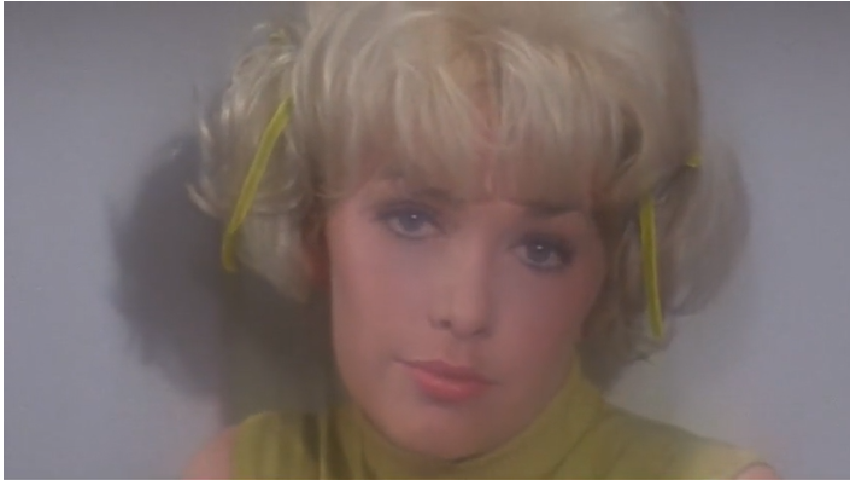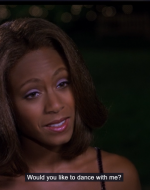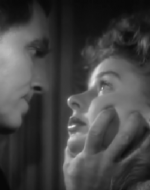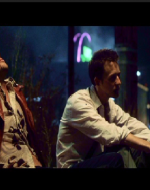Created by Julian Burgos on Tue, 11/29/2022 - 17:41
Description:
Introduction
The images that I have chosen I feel portray two ideas from the concept of the male gaze as discussed in class and explained in Laura Mulvey’s critical essay: the objectification of women in film and audience identification with characters onscreen, specifically male protagonists. Both ideas were worthy of having an entire gallery of their own, but I feel that they each represent crucial and important elements to understanding what the male gaze is, so I decided to include them both in my gallery. Countless films display this sexual objectification of women despite it not serving the narrative of the story. Films, like video games and the internet, can serve as an outlet for individuals to play out their fantasies and dream of a life where they obtain everything they wish for, whether it be money, fame, or the love of an objectively beautiful woman. However, what does it mean when film becomes an excuse to sexualize women’s bodies and acts as a vessel for playing out repressed individual’s fantasies? The four images that I chose explore this question. They range from loose adaptations of Jekyll and Hyde, or more specifically extensions as Henry Jenkins explains in his critical essay about transmedia storytelling, and films that we did not have the pleasure of viewing in class. The first two images are from both adaptions of The Nutty Professor that we viewed in class that feature audience participation and identification with the male protagonists in both films as well as the objectification of women. The third image is from a 1941 adaptation of Jekyll and Hyde we did not have the opportunity to view in class but shares many similarities with the 1931 version, starring the classic characters of Jekyll and Hyde but also characters made for the screen like Ivy. Lastly, and this is perhaps my favorite out of the images, is a still from the film Fight Club directed by David Fincher focusing on its two central characters (beware for spoilers) who share not only similarities with the trope of Jekyll and Hyde, but also have audience identification through the male gaze as well. It can be debated whether each of these films serve as either adaptations or extensions on Henry Jenkins’s spectrum for transmedia storytelling, but personally I feel that they lean heavily on the side of extensions rather than strict adaptations, especially with Fight Club.
Works Cited
Mulvey, Laura. “Visual Pleasure and Narrative Cinema.” Screen, vol. 16, no. 3, 1975, pp. 6–18., https://doi.org/10.1093/screen/16.3.6.
Henry Jenkins. “Transmedia Storytelling 101 - Pop Junctions.” Henry Jenkins, 22 Mar. 2007, http://henryjenkins.org/blog/2007/03/transmedia_storytelling_101.html.
The Nutty Professor. Directed by Jerry Lewis, Paramount Pictures, 1963.
The Nutty Professor. Directed by Tom Shadyac, Imagine Entertainment, 1996.
Dr. Jekyll and Mr. Hyde. Directed by Victor Fleming, MGM, 1941.
Fight Club. Directed by David Fincher, Fox 2000 Pictures, 1999.
The Nutty Professor. Directed by Jerry Lewis, Paramount Pictures,1963 (26:58).
This image is from the 1963 film The Nutty Professor starring Jerry Lewis. In the film, Jerry Lewis plays Professor Julius Kelp and his Hyde-esque counterpart Buddy Love, who unlike Kelp is socially magnetic and attracts the full attention of any room he is in. I chose this specific image because it is framed from the perspective of Kelp early in the film and because of its specific lighting. We know by this point that he has feelings for Stella Purdy, and the scene in focus here shows Stella inviting him to a social gathering later in the evening. As the scene continues, we slowly begin to zoom in closer to her face until what we see is the image above. Not only is she completely focused in by the director and at the center of the image, but the lighting changes to a subtle luminescence surrounding the actress playing Stella, Stella Stevens. She even looks directly at the audience by looking straight into the camera. This image not only highlights the audience identification concept from Laura Mulvey’s article, but it also displays the principles of objectification described in her article as well where she states that “in their traditional exhibitionist role women are simultaneously looked at and displayed, with their appearance coded for strong visual and erotic impact” (Mulvey, 62). The director is clearly evoking the male gaze in this scene by presenting Stella as this glorious prize for Kelp to obtain by literally being glowing on screen. Kelp is the weak, nerdy, and dorky male protagonist who lacks respect from his peers and by society’s standards of beauty has zero chance at attracting the attention of women. He becomes the male fantasy for many men in the audience who identify with his lack of romance and his longing for Stella, the girl he’s meant to have no chance with whatsoever because of society’s views toward the stereotypical geek.
The Nutty Professor. Directed by Tom Shadyac, Imagine Entertainment, 1996 (1:28:02)
This image is from the 1996 remake of The Nutty Professor released in 1963. I chose this image because of the specific framing and the primary subject of the image, which is protagonist Sherman Klump’s love interest, Carla Purty. The scene the image is taken from takes place after Sherman reveals to his colleagues at the university that he has been Buddy Love the entire time, the more charismatic but aggressive part of himself. Carla knows the truth about Sherman and knows that he lied to her throughout the majority of the film in order to impress her. In most situations, this would probably be a dealbreaker and Carla might not want to associate herself with Sherman after his revelation. However, this is not the case in this film riddled with extreme cases of the male gaze. Sherman is meant to be the hero of the story, and not only is he the hero, but he is male, and the male hero of the story has to win the girl at the end because according to the male gaze, the woman is an object and trophy meant to act as a reward for the hero. Carla forgives Sherman, and like the image suggests, she even asks him to dance with her and be his date for the evening. She is framed from Sherman’s perspective because the director intends us to identity with him and put ourselves in his shoes gazing at her as she is centered on the screen, his price to be collected as a final token for his efforts. The male fantasy of the social outcast, whether it be for physical reasons or just plain dorkiness, is presented here through Sherman, and even if it’s just for an hour and thirty-five-minute runtime, audiences that identify with his insecurities can imagine just for while that they too can “get the girl” at the end of the story despite their flaws. This concept is described at length in Mulvey’s article, where according to her, “as the spectator identifies with the main male protagonist, he projects his look on to that of his like, his screen surrogate, so that the power of the male protagonist as he controls events coincides with the active power of the erotic look, both giving a satisfying sense of omnipotence” (Mulvey, 63).
Dr. Jekyll and Mr. Hyde. Directed by Victor Fleming, MGM, 1941 (2:58)
This image is from the 1941 film Dr. Jekyll and Mr. Hyde, an adaptation of Robert Louis Stevenson’s Strange Case of Dr. Jekyll and Mr. Hyde. The image shows Spencer Tracy playing the film’s version of Mr. Hyde and Ingrid Bergman playing the character of Ivy Pearson, a character seen in the earlier film adaptation with the shared name Dr. Jekyll and Mr. Hyde from 1931. I chose this image because I feel it not only displays the objectification of women concept from the male gaze, but it adds another important element of identifying that objectification, which is the power dynamic and imbalance between these two characters. Jekyll is in his Hyde form, and while he may not boast the upper-class privilege that Dr. Jekyll possesses, he is still the one in control in this image as he is threatening and physically attacking Ivy. We see a closeup shot of the two characters, but Hyde is framed slightly above Ivy, showing the audience that is the one in power and the one in command. Ivy is at the mercy of this monster, and it is clear from the image that she is extremely uncomfortable and fearful for her life. The man she saw earlier is not who this person is in front of her, and she has no idea that they are in fact the same person. Henry Jenkins explains that adaptations take a story from one medium and retell it in another (Jenkins, 7). However, he also describes that extensions offer an opportunity to “add something to the existing story as it moves from one medium to another (Jenkins, 7). The original Jekyll and Hyde by Stevenson doesn’t even feature any female characters, but in pretty much any adaptation of Jekyll and Hyde you can find, there is a love interest, or at least several love interests created for the story. I would argue that adaptations like the image above and others like it are not exactly adaptations, but extensions of Stevenson’s work as they take creative freedoms when shifting to a different medium.
Fight Club. Directed by David Fincher, Fox 2000 Pictures, 1999 (0:35:50).
I chose this image from Fight Club not only because of the obvious similarities between the dynamic of Dr. Jekyll and Mr. Hyde, but also because of the concept of audience identification with male protagonists from the Laura Mulvey critical essay. Fight Club, directed by David Fincher, centers on an unnamed protagonist simply referred to as the Narrator played by Ed Norton. The Narrator is neurotic and suffers from insomnia, so he begins to seek out support groups in order to alleviate himself from the stresses of his work and romantic life. He is the character that audiences are supposedly meant to sympathize and identify with, at least in the first acts of the film. Everything changes once he meets Tyler Durden, played by Brad Pitt. Tyler is the direct antithesis to the Narrator. While the Narrator is someone who worries about the smallest things and the way that he is perceived by those around him, Tyler doesn’t worry about any of those things. He is cool, confident, handsome, and quite simply everything that the Narrator is not. It is not until late in the third act that Tyler is revealed to be simply a part of the Narrator’s consciousness. Tyler is the part of himself that is everything he wishes to be. He is the part of himself that wishes to rebel against the status quo and society’s expectations, as well as showcasing a dangerous glorification of toxic masculinity. The audience can thus identify with Tyler as well because he displays qualities of the perfect male human form as arranged by social constructs. Mulvey touches on this in her article, describing this phenomenon by explaining that “a male movie star’s glamourous characteristics are thus not those of the erotic object of the gaze, but those of the more perfect, more complete, more powerful ideal ego conceived in the original moment of recognition in front of the mirror” (Mulvey, 63). The male is not the object of the gaze, rather the audience puts themselves in their perspective instead and imagines themselves as the handsome movie star. The image above displays the differences between both characters primarily through their body language. The Narrator has his arms pulled closer together and leans forward with poor posture, while his face is covered in the shadows. Tyler, on the other hand, has his arms spread wide open and free while his relaxed face looks up towards the light, almost as if he is at peace with who he is, where he’s at in life, and what his true purpose is, everything that the Narrator lacks. The Narrator showcases the “weaker” qualities that Jekyll has in Stevenson’s book and other loose adaptations, such as a lack of self-confidence and a desire to be something greater, while Tyler Durden has more of a correlation with the violent Mr. Hyde and the liberation that Jekyll feels when he transforms into his alter ego. Simply put, Tyler is the Narrator’s chance at an escape from his mundane existence.





